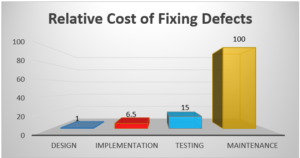Agile and Shift Left: The Good Part
If we look up the merits of Agile, one key benefit that comes up includes the ability to develop superior quality software. This is primarily achieved by introducing testing early in the software development life cycle. In today’s parlance, this is also known as Shift Left or Shift Left Testing.
The Systems Sciences Institute at IBM reported that the cost to fix a defect found in the maintenance phase can be up to 100x more than if the same defect was found in the design phase.

Source: IBM Systems Science Institute
When defects are caught early, not only does it reduce the cost of fixing them, but also offers – quicker and high-quality releases, reduced technical debt, and many more advantages.
Moreover, the greater collaboration among testers, developers, and business analysts means that they all strive towards improving the quality of releases and apprising customers of the progress, ultimately leading to greater customer satisfaction.
Agile and Shift Left: The Better Part
There is no doubting that Agile has helped bring the mindset change or the paradigm “left shift,” so to speak. Although functional testing has largely shifted left, traditional waterfall practices continue for non-functional testing, specifically performance and security testing. This leaves room open to undo all the hard work done in left shifting the functional testing. In our experience, even minute design flaws that remain untested initially can result in catastrophic performance issues in the later phases due to the cascading effect, something that could be easily avoided. A simple solution to this would be to perform rapid, lightweight testing of non-functional tests to quickly determine aspects that will require deeper testing towards the end of the cycle.
In the same vein, security testing using simple, open source tools can help check for common issues, such as the out-of-date libraries, OWASP top 10 vulnerabilities and then quickly be addressed during development.
Shifting both functional and non-functional testing left is in line with the philosophy of “Fail Fast, Fail Often”, which allows the opportunity to learn early and correct early, ultimately benefitting all the stakeholders.
Finally, DevOps: The Best Part
While shift-left focuses on integrating testing with development teams, DevOps goes a step further and aims to integrate the operations and the development team. What Agile and Shift Left could achieve was to lay a solid foundation on which DevOps could be built. Without those building blocks, achieving DevOps would only be a pipedream.
Many organizations that we have surveyed struggle to achieve true DevOps, as they lack proper test automation. We strongly believe that test automation is key to a strongly bonded DevOps without which it will continue to be a hyphenated “Dev-Ops.”
While most organizations would adopt DevOps practices on their current and newer projects, the legacy products that lacked test automation will continue to suffer. A technology partner like HealthAsyst can pitch in, supporting all your automation needs right from unit to regression testing to setting up the pipelines, so you can adopt DevOps with confidence. If you are ready to ride the DevOps wave, please write to us at itservices@healthasyst.com.
Do you agree with our thoughts? Have a comment to make? We would love to hear what you think. Drop us a line at itservices@healthasyst.com

